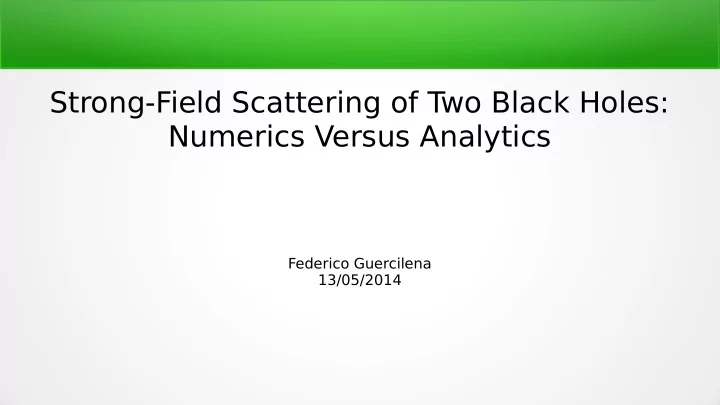

Strong-Field Scattering of T wo Black Holes: Numerics Versus Analytics Federico Guercilena 13/05/2014
Binary BHs on hyperbolic orbits
Defmection angle
Efgective One Body model ● from 2-body to 1-body problem ● Geodesic motion in Schwarzschild-like spacetime 2 =− A ( r ) d 2 + B ( r ) dr 2 + r 2 ( d θ 2 + sin 2 θ d ϕ 2 ) ds t 3 + a 4 ν u 4 A ( u ) 3 PN = 1 − 2 u + 2 ν u u = 1 / r ● Resummation as Padè approximant: 1 + a 2 u 2 + ... + a n A ( u )= a 0 + a 1 u n u 1 + b 2 u 2 + ... + b m 1 + b 1 u m u
„Padèing“ 1 + n 1 u A ( u )= 1 + d 2 u 2 + d 3 u 3 1 + d 1 u
Efgective One Body model ● A Hamiltonian of the system (describes conservative dynamics) ● Radiation reaction force terms to be added to the equation of motion ● A description of the asymptotic gravitational waveforms
Efgective One Body Hamiltonian H EOB ( r,p ϕ ,p r )= M √ 1 + 2 ν( H ef /μ− 1 ) H ef =μ √ A ( r )( 1 + J 2 u 2 2 ν( 4 − 3 ν) u 2 p 4 )+ p 2 r r ¯ ¯ r √ A p r = p ¯ B
EOB defmection angle χ u ax ( E,J ) U ( u,J ,H ef ) du −π 2 = ∫ 0 m 2 √ A ( u ) B ( b ) U ( u,J ,H ef )= J 2 − A ( u )( 1 + J √ H ef 2 u 2 )
Radiation reaction terms i ∂ x dt =∂ H ∂ p i i ∂ p t =−∂ H + F i d ∂ x i
Radiation reaction in the defmection angle ● When neglecting terms qudratic in F i (of order (v/c) 10 ) : ( non − conservative ) =χ ( conservative ) (¯ E, ¯ J ) χ E = 1 J = 1 ¯ ¯ 2 ( E incom ing + E outgoing ) 2 ( J incom ing + J outgoing )
Initial data Equal mass BHs (m=0.5 M) ● Non spinning ● Equal anti-parallel initial momenta ● (|p|=0.12 M) Initial separation: 100 M ● Varying impact parameter b ● T woPunctures code (spectral ● method)
Initial data: possible confjgurations
Initial energy and angular momentum b E/M J/M 2 9.6 1.0225555 1.099652 9.8 1.0225722 1.122598 10.0 1.0225791 1.145523 10.6 1.0225870 1.214273 11.0 1.0225884 1.260098 12.0 1.0255907 1.374658 13.0 1.0225924 1.489217 14.0 1.0225931 1.603774 15.0 1.0225938 1.718331 16.0 1.0225932 1.832883
Evolution ● BSSN formulation of Einstein equations ● Spatial derivatives: 8th-order fjnite-difgerence (McLachlan code) ● 7 box-in-box mesh refjnement levels for each BH ● Cartesian grid (no multipatch) ● Time evolution: Method of lines 4th-order Runge-Kutta time integrator
Radiated energy and angular momentum ● Weyl scalar psi4 ● Multipole decomposition up to l=8 ● 4 extraction radii ● Extrapolation to null infjnity ● Error sources: fjnite resolution, extrapolation, junk radiation
Defmection angle ● Polynomial fjt of theta as function of 1/r ● Extrapolation to 1/r=0 ● Choice of degree of the polynomial
Singular value decomposition ● Linear least squares problem: A x = b ● SVD decomposition: A = M W V T ● W = diag{w 1 ,w 2 ,..,w i } and x depends linearly on the reciprocals 1/w i ● T reshold T: if w n <T*max(w i ), then 1/w n =0 ● Coeffjcients and the extrapolant do not vary for polynomials of degree n>N
Results EOB EOB EOB EOB EOB PN PN PN b chi NR chi 5PN chi 4PN chi 3PN chi 2PN chi 1PN chi 3PN chi 2PN chi 1PN 9.6 305.8(2. 322(62) 364.29 ... ... ... 139.9 124.2 ... 6) 9.8 253.0(1. 261(14) 274.92 332.24 ... ... 131(2) 118.46 ... 4) 10.0 222.9(1. 227(5) 234.26 259.46 ... ... 126(1) 115.89 ... 7) 10.6 172.0(1. 172.8(7 174.98 182.09 220.11 260.53 118.5(3) 112.43 ... 4) ) 11.0 152.0(1. 152.4(3 153.59 157.68 177.60 194.90 114.7(2) 110.14 ... 3) ) 12.0 120.7(1. 120.77( 121.17 122.63 129.98 136.42 104.34(4 102.06 ... 5) 6) ) 13.0 101.6(1. 101.63( 101.80 102.48 106.20 109.80 93.69(2) 92.54 ... 7) 2) 14.0 88.3(1.8 88.348( 88.43 88.80 90.95 93.30 84.111(7 83.55 ... ) 8) ) 15.0 78.4(1.8 78.427( 78.47 78.69 80.03 81.699 75.962(3 75.71 169.298 ) 4) )
Results
Conclusions ● Compared full GR simulations of BHs on hyperbolic orbits with PN-EOB predictions ● Found agreement for the 5PN NR-calibrated EOB case for every b ● Even for non circular orbits ● Possibility of extracting information from scattering experiments to complete the EOB model
Recommend
More recommend